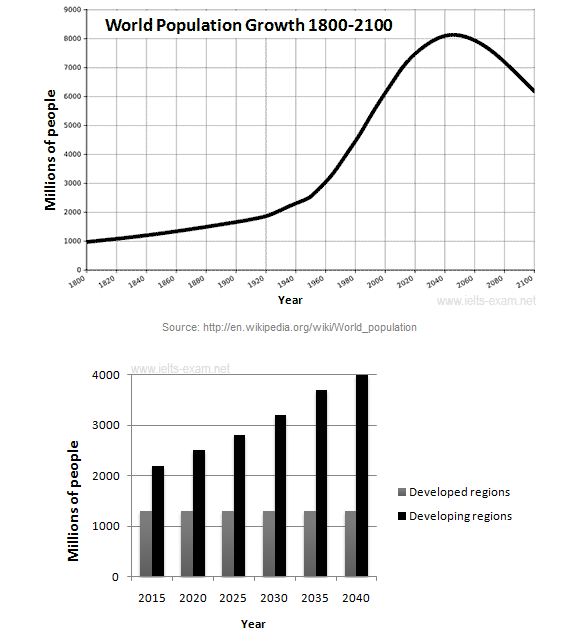IELTS WRITING TASK 1
The first chart illustrates the projection of global citizen development from 1800 to 2100, a 2-century period. Meanwhile, the second chart elucidates the changes of predicted number of people in two distinctive areas, namely urban and rural, over a 25-year period started from 2015 to 2040. Both figures are measured in millions of people.
The most important part to note from the first graph is that a fluctuation is foreseen to happen among human population in the world during the period of time. In addition, population of residents in urban and rural areas generally will experience significant, different changes with rural community following the pattern of worldwide growth and city citizens remaining stable.
As a starting point, by the year 1800, population number stood at 1,000 million people. In 1920, this number increased slowly to nearly twice of 1800's quantity. Continuously, the trend inclined in a considerable way by 4,000 million in 2000, and it will reach a peak at 8,000 million in 2040. After that, a drop is predicted to occur and remain 6,000 million inhabitants in the last projected year, 2100.
Otherwise, the trends in different areas, which started at above 1,000 million of urban residents and over 2,000 million of rural residents, is forecast to have dissimilar pattern over the predicted period. An unchanged trend of city population growth will make it stay at over 1,000 million until 2040, whilst a progressive rise will be able to be seen on rural society bringing the number to 4,000 million.
The first chart illustrates the projection of global citizen development from 1800 to 2100, a 2-century period. Meanwhile, the second chart elucidates the changes of predicted number of people in two distinctive areas, namely urban and rural, over a 25-year period started from 2015 to 2040. Both figures are measured in millions of people.
The most important part to note from the first graph is that a fluctuation is foreseen to happen among human population in the world during the period of time. In addition, population of residents in urban and rural areas generally will experience significant, different changes with rural community following the pattern of worldwide growth and city citizens remaining stable.
As a starting point, by the year 1800, population number stood at 1,000 million people. In 1920, this number increased slowly to nearly twice of 1800's quantity. Continuously, the trend inclined in a considerable way by 4,000 million in 2000, and it will reach a peak at 8,000 million in 2040. After that, a drop is predicted to occur and remain 6,000 million inhabitants in the last projected year, 2100.
Otherwise, the trends in different areas, which started at above 1,000 million of urban residents and over 2,000 million of rural residents, is forecast to have dissimilar pattern over the predicted period. An unchanged trend of city population growth will make it stay at over 1,000 million until 2040, whilst a progressive rise will be able to be seen on rural society bringing the number to 4,000 million.

ielts_writing_task_1.jpg
